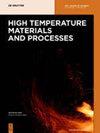Residual stress relaxation considering microstructure evolution in heat treatment of metallic thin-walled part
IF 1.6
4区 材料科学
Q4 MATERIALS SCIENCE, MULTIDISCIPLINARY
引用次数: 1
Abstract
Abstract The forming-induced residual stress of metallic parts could cause undesired deformation in the final machining process, especially for the thin-walled parts. Therefore, heat treatment is essential to release the residual stress prior to machining. This study investigates the residual stress change of a forged pure iron part in annealing heat treatment and material removal processes. A modified creep constitutive model with the consideration of microstructure evolution was established to describe the residual stress relaxation in the annealing. Stress relaxation tests were conducted to calibrate the material constants. This constitutive model was then implemented into the finite element model of annealing for the cold-forged semi-spherical shell. The residual stress and the grain size of the shell were predicted at different heating temperatures. The semi-spherical shells were machined to the final thin-walled parts, and the deformation owing to the residual stress release was measured and compared to the simulation results. The heating temperature was determined aiming to minimize the machining-induced deformation as well as to ensure the microstructure. This study could provide guidance to the elimination of the residual stress and the improvement of the geometrical accuracy for thin-walled parts in the machining process.考虑微观组织演变的金属薄壁件热处理残余应力松弛
摘要金属零件的成形残余应力会在最终加工过程中引起不期望的变形,尤其是薄壁零件。因此,在机加工之前,热处理对于释放残余应力至关重要。研究了锻造纯铁零件在退火热处理和材料去除过程中的残余应力变化。建立了一个考虑微观组织演变的修正蠕变本构模型来描述退火过程中的残余应力松弛。进行应力松弛试验以校准材料常数。然后将该本构模型应用于冷锻半球壳的退火有限元模型中。预测了不同加热温度下壳体的残余应力和晶粒尺寸。将半球形壳体加工成最终的薄壁零件,测量了残余应力释放引起的变形,并与模拟结果进行了比较。确定加热温度的目的是最大限度地减少机械加工引起的变形,并确保微观结构。该研究可为薄壁零件在加工过程中消除残余应力和提高几何精度提供指导。
本文章由计算机程序翻译,如有差异,请以英文原文为准。
求助全文
约1分钟内获得全文
求助全文
来源期刊

High Temperature Materials and Processes
工程技术-材料科学:综合
CiteScore
2.50
自引率
0.00%
发文量
42
审稿时长
3.9 months
期刊介绍:
High Temperature Materials and Processes offers an international publication forum for new ideas, insights and results related to high-temperature materials and processes in science and technology. The journal publishes original research papers and short communications addressing topics at the forefront of high-temperature materials research including processing of various materials at high temperatures. Occasionally, reviews of a specific topic are included. The journal also publishes special issues featuring ongoing research programs as well as symposia of high-temperature materials and processes, and other related research activities.
Emphasis is placed on the multi-disciplinary nature of high-temperature materials and processes for various materials in a variety of states. Such a nature of the journal will help readers who wish to become acquainted with related subjects by obtaining information of various aspects of high-temperature materials research. The increasing spread of information on these subjects will also help to shed light on relevant topics of high-temperature materials and processes outside of readers’ own core specialties.
 求助内容:
求助内容: 应助结果提醒方式:
应助结果提醒方式:


